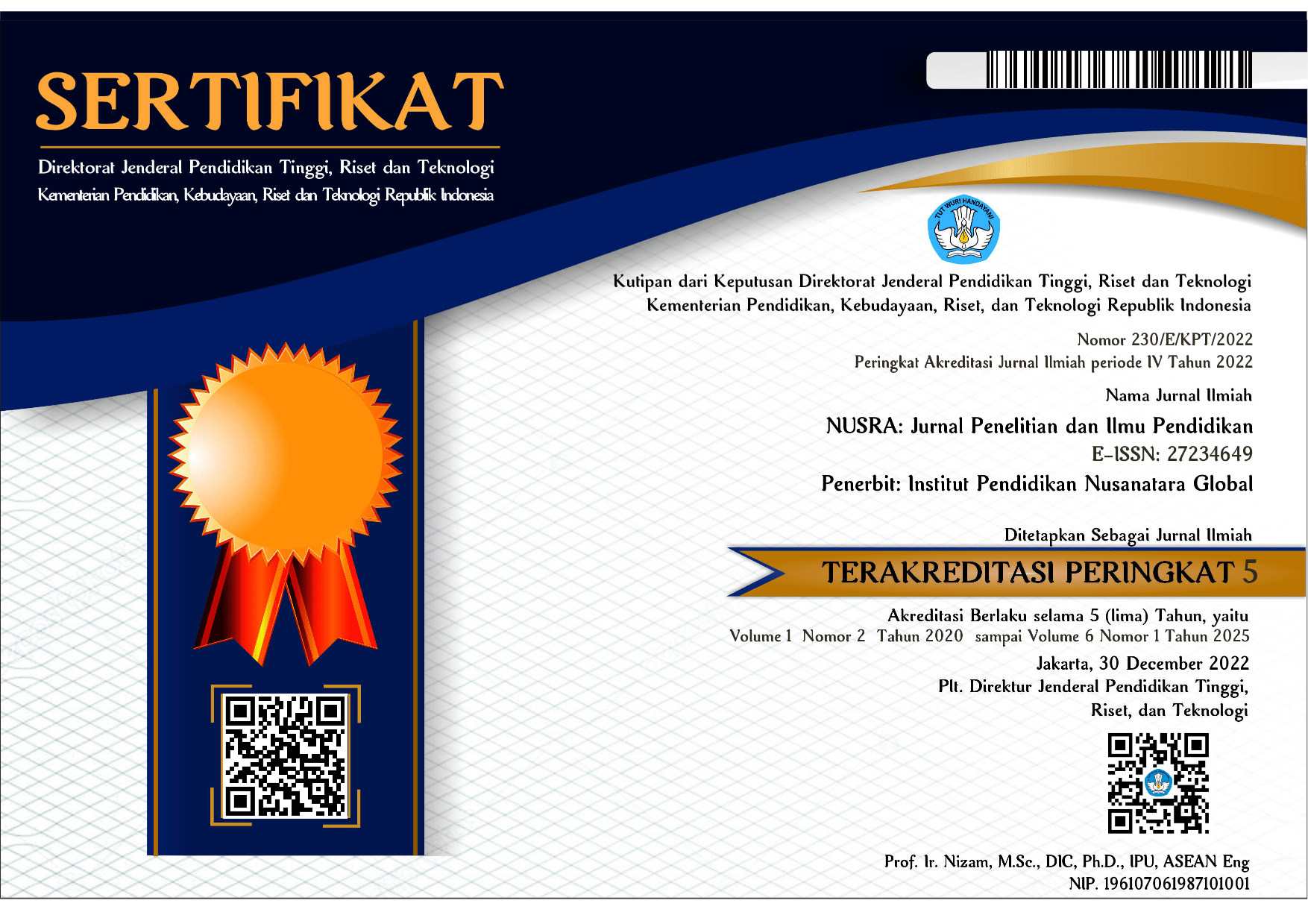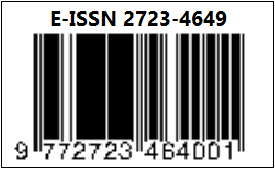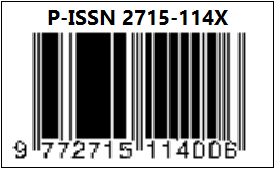Pendekatan Inovatif Dalam Pengembangan Peserta Didik Berdasarkan Karakteristik
DOI:
https://doi.org/10.55681/nusra.v6i1.3564Keywords:
cognitive, affective, psychomotor, studentAbstract
Education aims to develop the potential of students holistically through cognitive, affective, and psychomotor aspects. Characteristic-based development of students allows learning to be designed according to their unique needs, including learning styles, multiple intelligences, and social and cultural backgrounds. This article examines the strategy of developing students based on characteristics using a descriptive-analytical literature review method. The results of the study indicate that strategies that focus on student characteristics, such as problem-based and project-based learning, are able to optimize the development of cognition, affectivity, and psychomotor in a balanced manner. This approach supports the creation of effective learning that not only builds knowledge, but also positive attitudes and practical skills, so that students develop into individuals with character and competitiveness.
Downloads
References
Ali, Muhammad, ‘Guru Dalam Proses Belajar Mengajar Bandung: Sinar Baru’, 1996
Bloom, Benjamin S., and David R. Krathwohl, ‘Taxonomy of Educational Objectives: The Classification of Educational Goals, by a Committee of College and Univesity Examiners’, Handbook 1: Cognitive Domain, 1956, p. 10
Budiningsih, C. Asri, ‘Karakteristik Siswa Sebagai Pijakan Dalam Penelitian Dan Metode Pembelajaran’, Jurnal Cakrawala Pendidikan, 1.1 (2015), pp. 160–73, doi:10.21831/cp.v1i1.4198
Conklin, Jack, ‘A Taxonomy for Learning, Teaching, and Assessing: A Revision of Bloom’s Taxonomy of Educational Objectives Complete’, Phi Delta Kappa International, 83.44 (2005), pp. 154–59, doi:10.12816/0007239
Connell, J D, ‘Brain-Based Strategies to Reach Every Learner’, Scholastic Inc, 2005
Degeng, I Nyoman S, and Nyoman Sudana, ‘Ilmu Pengajaran Taksonomi Variabel’, Jakarta: Depdikbud, 1989
Fitriyah, Fitriyah, and Moh Bisri, ‘Pembelajaran Berdiferensiasi Berdasarkan Keragaman Dan Keunikan Siswa Sekolah Dasar’, Jurnal Review Pendidikan Dasar : Jurnal Kajian Pendidikan Dan Hasil Penelitian, 9.2 (2023), pp. 67–73, doi:10.26740/jrpd.v9n2.p67-73
Gallahue, David L, and John C Ozmun, ‘Understanding Motor Development: Infants, Children, Adolescents, Adults’, (No Title), 2006
Gardner, Howard E, Frames of Mind: The Theory of Multiple Intelligences (Basic books, 2011)
Hamzah, Syeh Hawib, ‘Aspek Pengembangan Peserta Didik: Kognitif, Afektif, Psikomotorik’, Dinamika Ilmu, 12.1 (2012), pp. 1–22
Harrow, Anita J, ‘A Taxonomy of the Psychomotor Domain. New York: David McKay Company’, Inc. New York, 1972
Indonesia, Pemerintah Republik, ‘Undang-Undang Republik Indonesia Nomor 20 Tahun 2003’, Pemerintah Republik Indoensia, 2003
Johnson, David W, and Roger T Johnson, Learning Together and Alone: Cooperative, Competitive, and Individualistic Learning (Prentice-Hall, Inc, 1987)
Khan, Muhammad Adil Abbas, and Zain A. Sobani, ‘Influence of Gender and Ethnicity on Problem-Based Learning’, Journal of Pioneering Medical Scienes, 2.3 (2012), pp. 122–26
Krathwohl, David R, Benjamin Samuel Bloom, and Bertram B Masia, ‘Taxonomy of Educational Objectives: The Classification of Educational Goals; Handbook’, 1966
Kurniasandi, Didik, Muhammad Zulkarnain, Shafrina Azzahra, and Bakti Anbiya, ‘Strategi Pembelajaran Berdiferensiasi Dan Implikasinya Untuk Menciptakan Pembelajaran Yang Inklusi Di Setiap Jenjang Pendidikan’, Jurnal Cerdik: Jurnal Pendidikan Dan Pengajaran, 3.1 (2023), pp. 56–64, doi:10.21776/ub.jcerdik.2023.003.01.06
Meilani, Leni, Bahja Bastulbar, and Wienike Dinar Pratiwi, ‘Dampak Pembelajaran Jarak Jauh Terhadap Aspek Kognitif, Afektif, Dan Psikomotor Bagi Siswa Sekolah Menengah Atas (SMA)’, Jurnal Pendidikan Bahasa Dan Sastra Indonesia Undiksha, 11.3 (2021), pp. 282–87, doi:10.23887/jjpbs.v11i3.31476
Nafiah, Tri, Yuyun Yulia, Titik Muti’ah, and Banun Havivah Cahyo Khosiyono, ‘Implementasi Pembelajaran Berdiferensiasi Mengakomodir Kebutuhan Belajar Murid’, Journal of Elementary Education SINTA, 8.2 (2024)
Nafiati, Dewi Amaliah, ‘Revisi Taksonomi Bloom: Kognitif, Afektif, Dan Psikomotorik’, Humanika, 21.2 (2021), pp. 151–72, doi:10.21831/hum.v21i2.29252
Piaget, Jean, and Barbel Inhelder, The Psychology of the Child (Basic books, 2008)
Presiden Republik Indonesia, ‘Standar Nasional Pendidikan’, 102501, 2021
Pritchard, Alan, Ways of Learning: Learning Theories for the Classroom (Routledge, 2017)
Putra, Rizky Pratama, Muhmmad Ainul Yaqin, and Akhmadiyah Saputra, ‘Objek Evaluasi Hasil Belajar Pendidikan Agama Islam: Analisis Taksonomi Bloom (Kognitif, Afektif, Psikomotorik)’, Jurnal Of Islamic And Education Research, 2.1 (2024), pp. 149–58
Santrock, John W, Educational Psychology (McGraw-Hill, 2011)
Singer, Dorothy G, and Tracey A Revenson, A Piaget Primer: How a Child Thinks; Revised Edition (Penguin, 1996)
Smaldino, Sharon E, Deborah L Lowther, James D Russell, and Clif Mims, ‘Instructional Technology and Media for Learning’, 2008
Vygotsky, Lev S, Mind in Society: The Development of Higher Psychological Processes (Harvard university press, 1978), lxxxvi
Wahyuni, Andi Eki Dwi, Muhammad Yahya, and Ambo Asse, ‘Metode Pendidikan Berdiferensiasi Bagi Generasi Z Dalam Perspektif Hadis’, JIEP: Journal of Islamic Education Papua, 2.1 (2024), pp. 18–30
Yaumi, Muhammad, ‘Pembelajaran Berbasis Multiple Intelligences’, 2019
———, Prinsip-Prinsip Desain Pembelajaran: Disesuaikan Dengan Kurikulum 2013 Edisi Kedua (Kencana, 2017)
Downloads
Published
How to Cite
Issue
Section
License
Copyright (c) 2025 Andi eki Dwi wahyuni, Muljono Damopolii, Yuspiani

This work is licensed under a Creative Commons Attribution-ShareAlike 4.0 International License.














